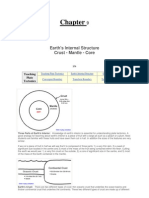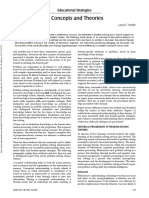FAULT
FAULT
Uploaded by
Joyce De GuzmanCopyright:
Available Formats
FAULT
FAULT
Uploaded by
Joyce De GuzmanOriginal Description:
Copyright
Available Formats
Share this document
Did you find this document useful?
Is this content inappropriate?
Copyright:
Available Formats
FAULT
FAULT
Uploaded by
Joyce De GuzmanCopyright:
Available Formats
WHAT IS FAULTS
Faults may be vertical, horizontal, or inclined at any angle. Although the angle of inclination of a
specific fault plane tends to be relatively uniform, it may differ considerably along its length from place
to place. When rocks slip past each other in faulting, the upper or overlying block along the fault plane is
called the hanging wall, or headwall; the block below is called the footwall. The fault strike is the
direction of the line of intersection between the fault plane and Earth’s surface. The dip of a fault plane
is its angle of inclination measured from the horizontal.
Faults are classified according to their angle of dip and their relative displacement. Normal dip-slip
faults are produced by vertical compression as Earth’s crust lengthens. The hanging wall slides down
relative to the footwall. Normal faults are common; they bound many of the mountain ranges of the
world and many of the rift valleys found along spreading margins of tectonic plates. Rift valleys are
formed by the sliding of the hanging walls downward many thousands of metres, where they then
become the valley floors.
types of faulting in tectonic earthquakes
In normal and reverse faulting, rock masses slip vertically past each other. In strike-slip faulting, the
rocks slip past each other horizontally.
Encyclopædia Britannica, Inc.
A block that has dropped relatively downward between two normal faults dipping toward each other is
called a graben. A block that has been relatively uplifted between two normal faults that dip away from
each other is called a horst. A tilted block that lies between two normal faults dipping in the same
direction is a tilted fault block.
Get a Britannica Premium subscription and gain access to exclusive content.Subscribe Now
Reverse dip-slip faults result from horizontal compressional forces caused by a shortening, or
contraction, of Earth’s crust. The hanging wall moves up and over the footwall. Thrust faults are reverse
faults that dip less than 45°. Thrust faults with a very low angle of dip and a very large total
displacement are called overthrusts or detachments; these are often found in intensely deformed
mountain belts. Large thrust faults are characteristic of compressive tectonic plate boundaries, such as
those that have created the Himalayas and the subduction zones along the west coast of South America.
Strike-slip (also called transcurrent, wrench, or lateral) faults are similarly caused by horizontal
compression, but they release their energy by rock displacement in a horizontal direction almost parallel
to the compressional force. The fault plane is essentially vertical, and the relative slip is lateral along the
plane. These faults are widespread. Many are found at the boundary between obliquely converging
oceanic and continental tectonic plates. Well-known terrestrial examples include the San Andreas Fault,
which, during the San Francisco earthquake of 1906, had a maximum movement of 6 metres (20 feet),
and the Anatolian Fault, which, during the İzmit earthquake of 1999, moved more than 2.5 metres (8.1
feet).
Reference
https://www.britannica.com/science/fault-geology#ref93069
You might also like
- GEO Report 1Document13 pagesGEO Report 1Patricia Tapia JamachiNo ratings yet
- Toyota Voxy 1 Az ManualDocument5 pagesToyota Voxy 1 Az Manualmarran almarrany60% (5)
- Destructive, Constructive and Conservative Plate MarginsDocument11 pagesDestructive, Constructive and Conservative Plate MarginsRavi MothoorNo ratings yet
- Hindi Terminology of Geological TermsDocument38 pagesHindi Terminology of Geological TermsSUDHIBRATA RAYNo ratings yet
- Geology of Egypt DR - FatheDocument48 pagesGeology of Egypt DR - FatheSuman Biswas83% (6)
- Science: Common Atmospheric PhenomenaDocument33 pagesScience: Common Atmospheric PhenomenaMelanie Tagudin Trinidad80% (5)
- Reference: Harmening, D. M. (2012) - Modern Blood Banking & Transfusion Practices (6th Ed.) - Pp. 434Document5 pagesReference: Harmening, D. M. (2012) - Modern Blood Banking & Transfusion Practices (6th Ed.) - Pp. 434Kolin N Jandoc100% (1)
- Chapter 9Document130 pagesChapter 9Andy ChauNo ratings yet
- Sesar NaikDocument61 pagesSesar NaikTito TahtaNo ratings yet
- 3 FaultsDocument36 pages3 FaultsBISUNo ratings yet
- Folds&Faults PresentationDocument17 pagesFolds&Faults Presentationcrown212No ratings yet
- Topic:Inclined Bedding (Fold) (Lab 2A) 1.0 ObjectiveDocument11 pagesTopic:Inclined Bedding (Fold) (Lab 2A) 1.0 ObjectiveKaizoku-ONo ratings yet
- PPT2actMod - Geological Map and SectionsDocument35 pagesPPT2actMod - Geological Map and SectionsAbdilbasit HamidNo ratings yet
- UnconformityDocument12 pagesUnconformityTapos Kumar GoswamiNo ratings yet
- Govt. V. Y. T. PG. Autonomous College Durg: Guided by Presented byDocument23 pagesGovt. V. Y. T. PG. Autonomous College Durg: Guided by Presented bydeshmukhgeolNo ratings yet
- ENGINEERING GEOLOGY Unit 4Document75 pagesENGINEERING GEOLOGY Unit 4Vinoshri50% (2)
- Evolution & Potential of East Africa Rift SystemDocument15 pagesEvolution & Potential of East Africa Rift SystemDenis MulondoNo ratings yet
- TrapsDocument57 pagesTrapsYoussef Waled MohamedNo ratings yet
- Mass WastingDocument64 pagesMass WastingEkala XuhalxNo ratings yet
- Geological StructuresDocument25 pagesGeological StructuresSyahdan HamzahNo ratings yet
- A Presentation On Folds, Faults and Unconformity-1Document32 pagesA Presentation On Folds, Faults and Unconformity-1Rakesh Kumar100% (1)
- Grade 10 FLUVIAL PROCESSDocument36 pagesGrade 10 FLUVIAL PROCESSsuckoofabianNo ratings yet
- Dip, Strike and FoldsDocument34 pagesDip, Strike and Foldssaira tahir100% (1)
- 3 UnconformityDocument15 pages3 UnconformitymbintaherNo ratings yet
- Geology Structure, A Pratical Introduction, FoldsDocument61 pagesGeology Structure, A Pratical Introduction, FoldsFoulaniNo ratings yet
- System TractsDocument14 pagesSystem TractsTayyab FiazNo ratings yet
- Fault, Fold, Dip, Strike, Joint in Geology PART 2 UNIT 2Document46 pagesFault, Fold, Dip, Strike, Joint in Geology PART 2 UNIT 2tagavi9129No ratings yet
- Influence of Faulting On DrainageDocument27 pagesInfluence of Faulting On DrainageKartel Gunter100% (1)
- Lecture 9Document20 pagesLecture 9briceboris100% (1)
- ValleyDocument2 pagesValleyjanasoNo ratings yet
- Geomorphology Notes by Swagat PradhanDocument51 pagesGeomorphology Notes by Swagat PradhanDanis KhanNo ratings yet
- 9 Interior of The EarthDocument50 pages9 Interior of The EarthNaga Lakshmi100% (1)
- The Origin of Weipa Bauxite PDFDocument5 pagesThe Origin of Weipa Bauxite PDFluiferinconNo ratings yet
- 13 - 14 - I - GS-7 (Folds)Document120 pages13 - 14 - I - GS-7 (Folds)Dhany RizkyNo ratings yet
- Sequence Stratigraphy in ExplorationDocument9 pagesSequence Stratigraphy in Explorationnhora1985No ratings yet
- King's ModelDocument10 pagesKing's ModelRanitNo ratings yet
- Drainage PatternsDocument3 pagesDrainage PatternsDimas NinoNo ratings yet
- Coastal Processes and Landform: Submitted ToDocument18 pagesCoastal Processes and Landform: Submitted ToZubair KambohNo ratings yet
- Plate Tectonic History of The Indian OceanDocument22 pagesPlate Tectonic History of The Indian OceanInternational Journal of Innovative Science and Research Technology100% (1)
- Continental Drift Seafloor SpreadingDocument30 pagesContinental Drift Seafloor SpreadingRainier Magno100% (1)
- Fault Slip and Fault NamesDocument4 pagesFault Slip and Fault Namesanima1982No ratings yet
- Chapter-3 The Physiography of EthiopiaDocument59 pagesChapter-3 The Physiography of EthiopiaNemeab ElmiNo ratings yet
- William Morris DavisDocument7 pagesWilliam Morris DavisB. R. HosenNo ratings yet
- Fluvial Processes and LandformsDocument25 pagesFluvial Processes and LandformsA S Verma100% (1)
- Glossary of GeomorphologyDocument84 pagesGlossary of GeomorphologyeabsNo ratings yet
- Strain EllipsoidDocument7 pagesStrain EllipsoidArkaprabha Sarkar100% (1)
- What Are Folds? What Is Their Geologic Importance?Document18 pagesWhat Are Folds? What Is Their Geologic Importance?Arindom100% (1)
- Salt Dome: This Article Needs Additional Citations For VerificationDocument18 pagesSalt Dome: This Article Needs Additional Citations For VerificationAniefiok EmmanuelNo ratings yet
- Chapter - 16 Coast and Coral ReefsDocument50 pagesChapter - 16 Coast and Coral ReefsgopeNo ratings yet
- Coasts Key Word Glossary (1) MDocument5 pagesCoasts Key Word Glossary (1) MRia PatelNo ratings yet
- Petroleum Geology: 1 Prepared By: M. TalimbayDocument10 pagesPetroleum Geology: 1 Prepared By: M. TalimbayClark Holden MacasaetNo ratings yet
- Igneous Activity at The Present Day: TopicDocument4 pagesIgneous Activity at The Present Day: TopicMuhammad Bilal PaulNo ratings yet
- East African Rift ValleyDocument4 pagesEast African Rift ValleyAcap Razak100% (1)
- Strike Dip and Dip Direction of Geological StructuresDocument10 pagesStrike Dip and Dip Direction of Geological StructuresRehman AbbasiNo ratings yet
- Geology of Indonesia at GlanceDocument8 pagesGeology of Indonesia at GlanceSundar RajNo ratings yet
- Aeolian Processes and Landforms: Md. Ilias MahmudDocument44 pagesAeolian Processes and Landforms: Md. Ilias MahmudGazi Arifur RahmanNo ratings yet
- The Wallace-Bott HypothesisDocument5 pagesThe Wallace-Bott HypothesisAnonymous EMS9x6No ratings yet
- Orogeny: 1 PhysiographyDocument7 pagesOrogeny: 1 PhysiographyafjkjchhghgfbfNo ratings yet
- Anatomy of A Subduction ZoneDocument1 pageAnatomy of A Subduction ZonecvytasekNo ratings yet
- GEOG 111 FInal NotesDocument17 pagesGEOG 111 FInal NotesappleNo ratings yet
- CH 1. Introduction To Structural GeologyDocument51 pagesCH 1. Introduction To Structural Geologyelias assefaNo ratings yet
- Fundamentals of Geology & Soil Science (Safo - 1102)Document31 pagesFundamentals of Geology & Soil Science (Safo - 1102)ShijithNo ratings yet
- Earth's WatersDocument17 pagesEarth's Waterskaye last nameNo ratings yet
- FOLDSand FAULTSDocument21 pagesFOLDSand FAULTSC John AquinoNo ratings yet
- Nationalism: Issues and Concerns: Dev Raj AryalDocument6 pagesNationalism: Issues and Concerns: Dev Raj AryalJoyce De GuzmanNo ratings yet
- PersonaDocument1 pagePersonaJoyce De GuzmanNo ratings yet
- Discipline and Ideas in Applied Social ScienceDocument4 pagesDiscipline and Ideas in Applied Social ScienceJoyce De Guzman100% (1)
- What Is Logic BombDocument1 pageWhat Is Logic BombJoyce De GuzmanNo ratings yet
- Physical Security DefinitionDocument1 pagePhysical Security DefinitionJoyce De Guzman100% (1)
- Bestolife® 4010® NMDocument2 pagesBestolife® 4010® NMJorge ForeroNo ratings yet
- Invoice AbitamaHydro 06021Document1 pageInvoice AbitamaHydro 06021RomyNo ratings yet
- Usa Amc - 12 Ahsme 2013Document10 pagesUsa Amc - 12 Ahsme 2013Wang WilliamNo ratings yet
- Abit AX78 Motherboard ManualDocument80 pagesAbit AX78 Motherboard ManualDuckyLuckyNo ratings yet
- Prescolite Architectural Lighting Catalog G-17 1969Document104 pagesPrescolite Architectural Lighting Catalog G-17 1969Alan MastersNo ratings yet
- 251 North Bridge Road Singapore 179102 Visit Us at "WWW - Lta.gov - SG"Document2 pages251 North Bridge Road Singapore 179102 Visit Us at "WWW - Lta.gov - SG"YADI JAYADINo ratings yet
- Solar Energy: Haohui Liu, Armin G. Aberle, Tonio Buonassisi, Ian Marius PetersDocument7 pagesSolar Energy: Haohui Liu, Armin G. Aberle, Tonio Buonassisi, Ian Marius PetersindrasyifaiNo ratings yet
- Leadership in The Digital EraDocument9 pagesLeadership in The Digital EratheDragongaming 201No ratings yet
- Jvme 30 3 226Document4 pagesJvme 30 3 226Chelwin Glenn Pelaez AsuncionNo ratings yet
- Post Covid 19 Market TrendsDocument40 pagesPost Covid 19 Market TrendsKaran Ojha100% (1)
- High Tensile Stock ListDocument68 pagesHigh Tensile Stock ListJJ FloresNo ratings yet
- B.E (2019 Pattern)Document915 pagesB.E (2019 Pattern)royajoy607No ratings yet
- A ReviewDocument17 pagesA ReviewkanomasiNo ratings yet
- M06S2AI3Document6 pagesM06S2AI3manu bb100% (2)
- Filter DesignDocument6 pagesFilter Designnaga7389No ratings yet
- History of Magic and Experimental Science The Fourteenth and Fifteenth Centuries PDFDocument393 pagesHistory of Magic and Experimental Science The Fourteenth and Fifteenth Centuries PDFM. Carolina Escobar V.100% (1)
- Beta 3 B118a Sigma Active Subwoofer Speaker SystemDocument4 pagesBeta 3 B118a Sigma Active Subwoofer Speaker SystemGabriel0% (1)
- Management of Tooth Size Arch Perimeter DiscrepancDocument5 pagesManagement of Tooth Size Arch Perimeter DiscrepancFabio RibeiroNo ratings yet
- Grammar Practice Level1 Answer KeyDocument7 pagesGrammar Practice Level1 Answer KeyWisrut MueangkaeoNo ratings yet
- 10 Mechanical Equipment, Attachment PDFDocument8 pages10 Mechanical Equipment, Attachment PDFPeter BrickNo ratings yet
- Nitrosaminas em Preservativos e BalõesDocument4 pagesNitrosaminas em Preservativos e BalõeseveltoncNo ratings yet
- Leakage Detection Using Fiber Optics Distributed Temperature MonitoringDocument8 pagesLeakage Detection Using Fiber Optics Distributed Temperature MonitoringeochiufpicNo ratings yet
- 38007111M PDFDocument95 pages38007111M PDFPak NdutNo ratings yet
- BUET EXAMS Questions 2-4-16Document5 pagesBUET EXAMS Questions 2-4-16tanveerhossain1100% (1)
- Examination, Diagnosis and Treatment Planning For Complete Denture TherapyDocument7 pagesExamination, Diagnosis and Treatment Planning For Complete Denture TherapyAmar Bimavarapu100% (1)
- Boq 608553Document15 pagesBoq 608553sahil kotwalNo ratings yet






























































































